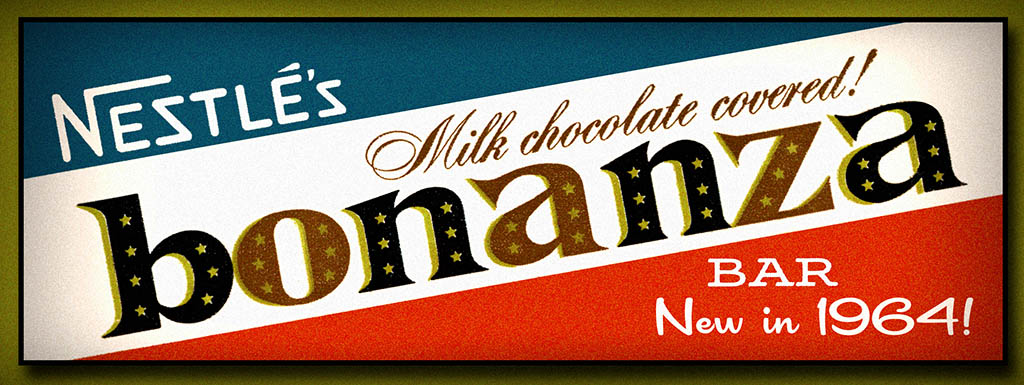
Today’s post is one I am especially excited to publish as the Bonanza bar has been on my list of lost-to-history brands I’ve long sought to uncover evidence on. Until today, there have never been images or references to the Nestle Bonanza bar anywhere online – not a single mention – it was un-Google-able – but no more. This entry is not only about the Bonanza bar, but about how two similar product launches can lead to very different outcomes. So make the jump to check out Nestle’s long forgotten Bonanza bar!
As I indicated in my introduction, information on the Bonanza bar has been non-existent online. So my research on the brand was based solely on what I could find in my historical materials and what I could track down over the years. The first hard evidence I found on Bonanza came in the form of a newspaper ad proof, dated 1964. This would be the first time I’d see what the Bonanza bar looked like, and it also revealed the direction of the brand’s initial marketing campaign. When it came to me a couple of years ago, this piece was brittle, torn and damaged, but thankfully it was complete and I was able to create a pretty good scan of it in spite of the damage the years had taken. Here it is:
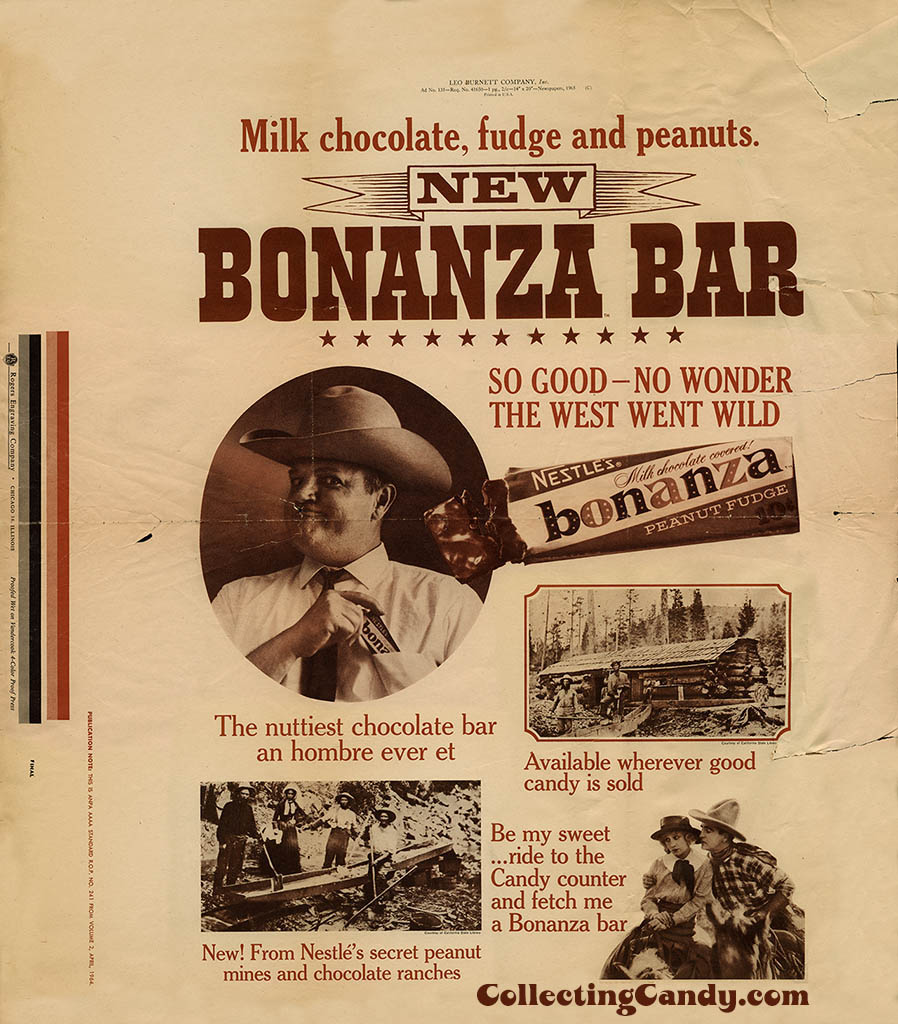
Nestle – Bonanza Bar – Newspaper Ad – File Proof Copy – 1964-65
As you can see, the initial campaign took an old-west theme, which makes a lot of sense if you put the launch into perspective. Just a few years earlier, the Bonanza television show featuring the adventures of Ben Cartwright and his sons launched to huge ratings across the country. By 1964, the Bonanza television program was a favorite entertainment to millions of consumers and we can assume that Nestle believed it would be the perfect brand name to choose because of that fact.
I’m going to cover more on the implications of the Bonanza bar launch shortly, but first I want to cover the most exciting element of today’s post – my recent acquisition of an actual Bonanza bar.
I was contacted in early December by a friend and advertising collector who was clearing out some old candy pieces from his own collection and one of them was a Bonanza bar. But it wasn’t just a wrapper – it was an unopened bar from the 1960’s! Of course I agreed to acquire it and a few weeks later it arrived intact and still unopened, after half-a-century:
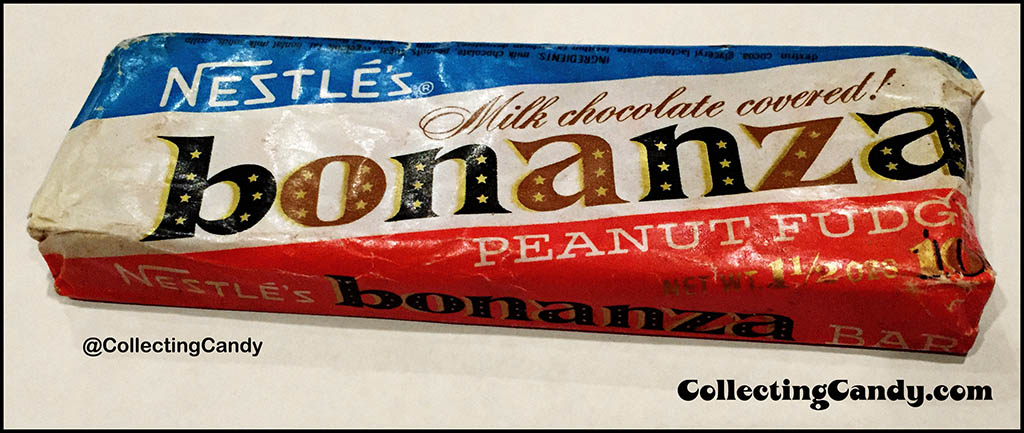
Nestle’s 1964 Bonanza bar – unopened package
Publishing these kinds of images is especially satisfying for me knowing that the Bonanza bar will no longer be lost to history and is finally being documented.
Having an unopened chocolate bar from 50+ years ago is a remarkable thing, but my goal has always been documentation and long-term preservation. I consider actual chocolate inside a package like this a danger to that long-term preservation goal, so I did open and remove the contents of this package. The bar inside was remarkably well-kept, though the years of holding a chocolate bar did wear on the red-white-and-blue wrapper. Here’s a look at the bar, moments after I opened the package:
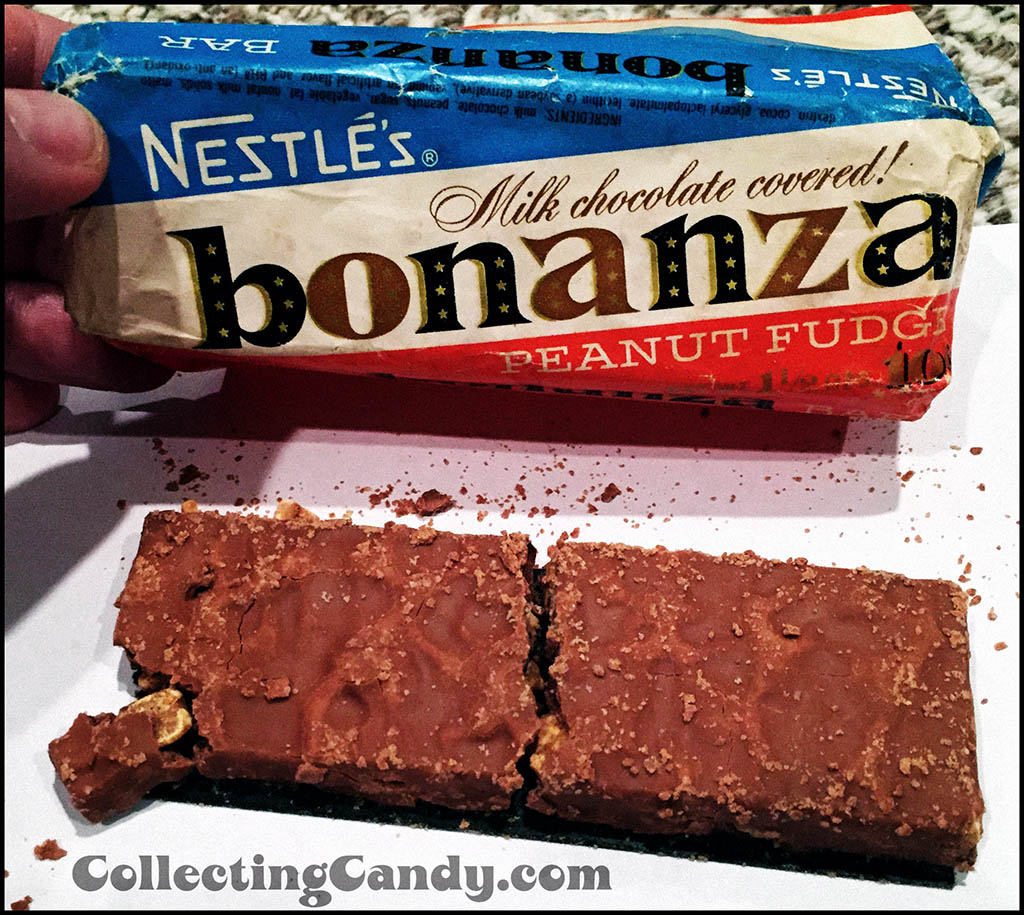
Nestle’s 1964 Bonanza bar unopened bar exposed photo
With great care and patience, I flattened the wrapper and endeavored to clean the residual guck that was left on it (a mix of the original adhesives that sealed the wrapper along with oils from the bar itself – a strange kind of greasy residue). The result is a great look at (and currently the only known image of) the original Nestle Bonanza bar wrapper from 1964. Here it is!
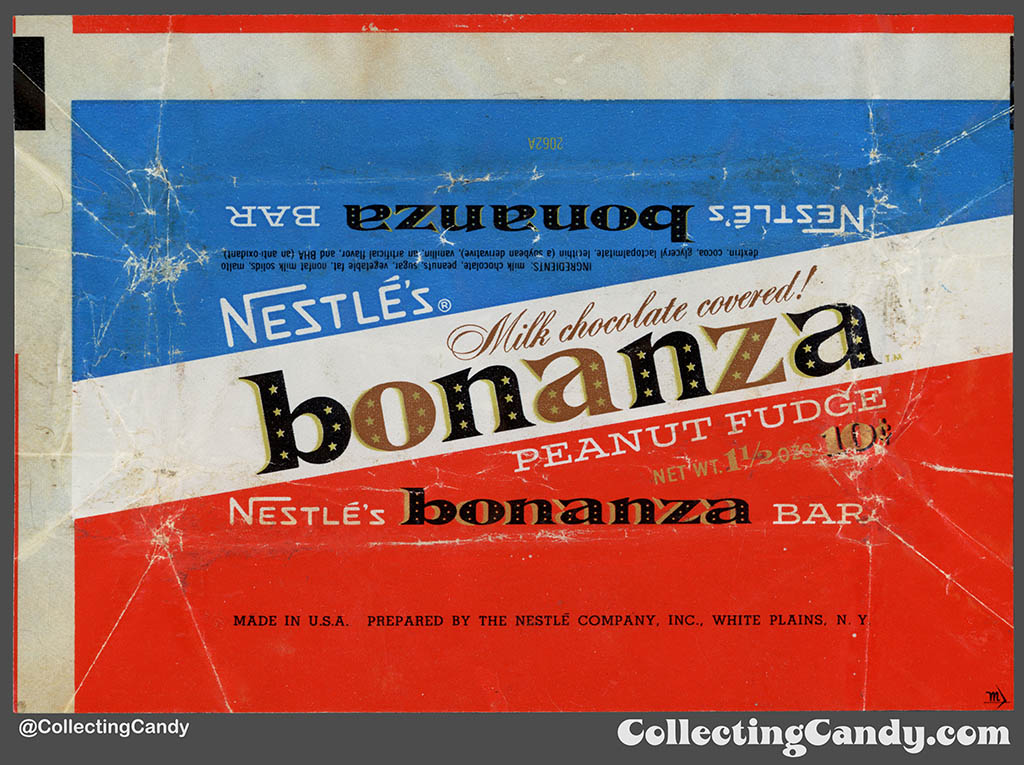
Nestle’s – Bonanza Bar – 10-cent 1 1/2 oz chocolate candy bar wrapper – 1964-65
Isn’t that a beauty? I love it!
Now, for those of you with a historical interest, you may note that this wrapper shares some design commonalities with another Nestle launch from 1964, the $100,000 bar (now known as Nestle’s 100 Grand). And that brings me to our tale of two product launches.
The Bonanza bar and the $100,000 bar both launched in 1964, and both share a similar design philosophy as you can see here:
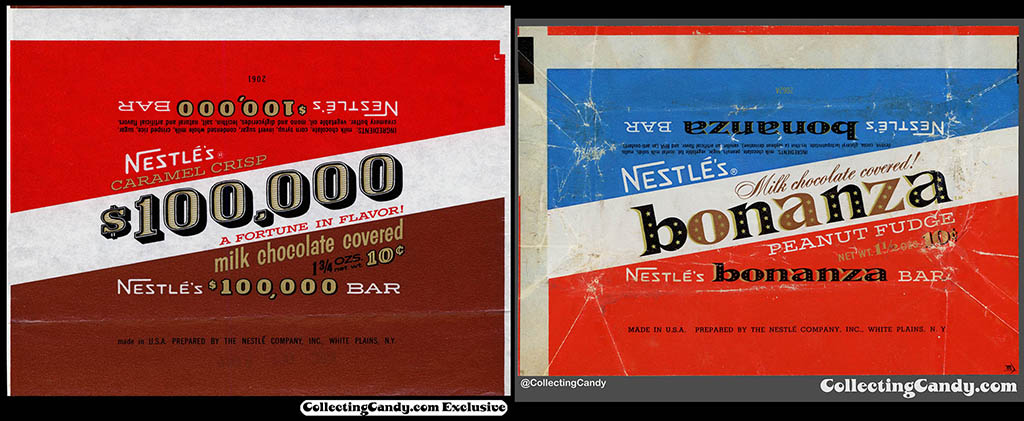
Nestle’s 1964 $100,000 bar and Bonanza bar compare and contrast
Not only did both bars launch in 1964 and utilize a similar look, but it is said that the $100,000 bar’s name was inspired by a hit game show at the time, so both bars had brand names that may have been inspired by popular television programs. The initial newspaper ad campaigns had some similarity as well, with one featuring a vintage gangster and the other a vintage cowboy:
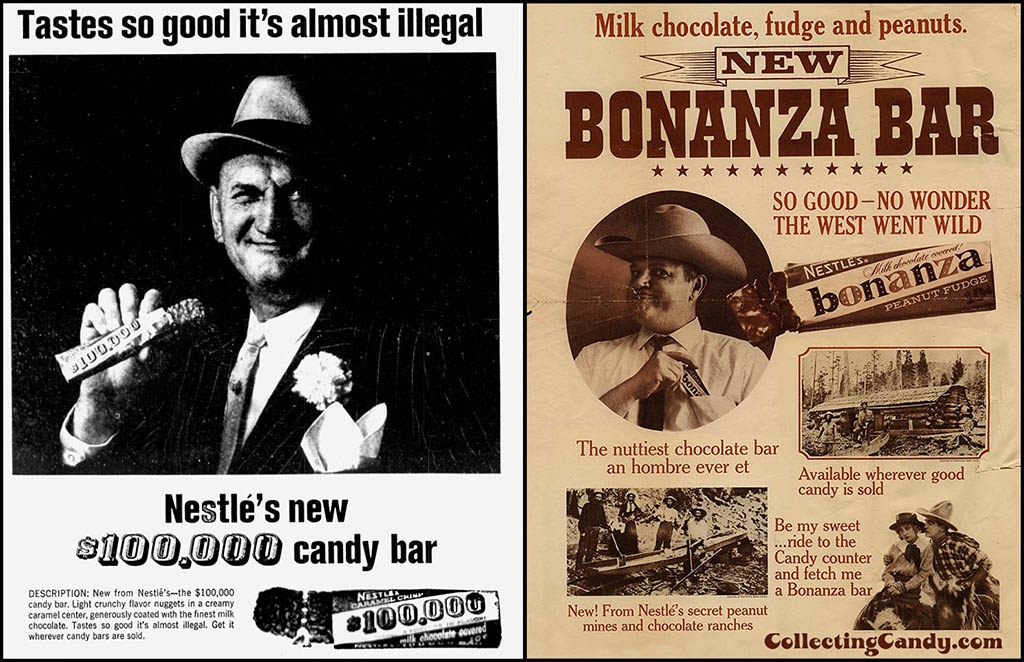
Nestle’s 100,000 and Bonanza 1964 bar newspaper ads compared
So both bars shared remarkably similar origins and yet one went on to become an iconic American brand recently surpassing 50 years on store shelves, while the other one only made a brief retail appearance before it disappeared and was forgotten (until today).
Unless someone with inside knowledge of the situation from that time comes forward with new information, it is unlikely that the tale of what made one a hit and the other one not will remain historical speculation, but at least now we can look back and wonder.
[Edit: Eagle-eyed reader and researcher John Simpson found a reference to the Bonanza bar in an unexpected place – the Google Books repository for Billboard magazine. Within that mention, it is confirmed that the Bonanza bar first went into regional market testing and distribution in Buffalo, New York and Portland, Oregon before getting a national rollout.]
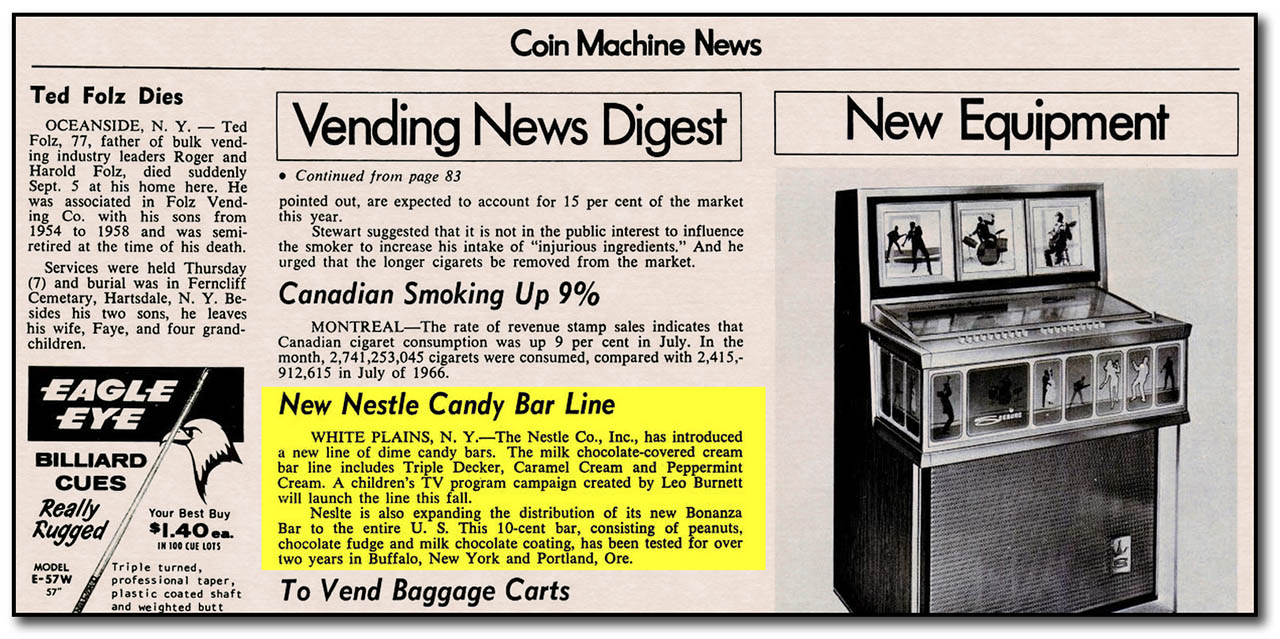
Nestle Bonanza Billboard magazine September 16th, 1967
And that is everything I’ve got on the (previously) forgotten Nestle Bonanza bar and the tale of two product launches. I hope you’ve enjoyed the look back and I’ll see you next time!
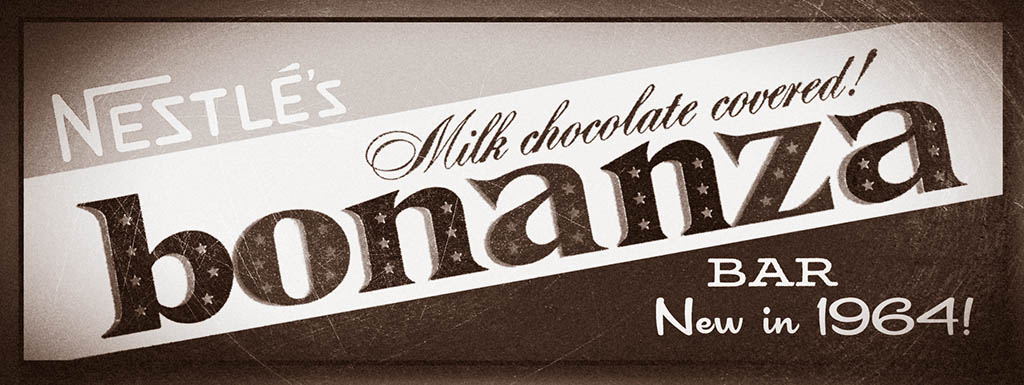



Fascinating! A great exploration of candy history.
Wow, that was a great find and great article Jason! I’d never heard of the Bonanza bar and it sure is a killer design. I knew where you were headed in regard to preserving the wrapper -and I totally get it- but I must admit it still pains me a little bit to see those long-preserved packages opened! 😉
Thank you for sharing this. I had never heard of it until your blog. That candy bar managed to look not too bad for being over 50 years old!
To access contemporary articles on stuff like this I use Google Books.
I found a 1967 news item in Billboard magazine referring to the distribution and test marketing campaign for the Bonanza bar
https://books.google.com/books?id=XygEAAAAMBAJ&lpg=RA1-PA84&dq=nestle%20bonanza%20bar&pg=RA1-PA84#v=onepage&q=nestle%20bonanza%20bar&f=false
It seems from 1964-67 it was test marketed in Buffalo, NY and Portland, OR and 1967 was supposed to be the year of national distribution.
Great bit of confectionery research John – and from a surprising source! Thanks!
Awesome find! I enjoy your photos on instagram and have now found your website.
I lived in oregon starting in 64 to present. I was nine when we moved to oregon. I had a paper route
As a mid and on my route was a McKay’s .market that sold bonanza bars. The were in a large metal tub at the front of the store.
Hi, I am from Erie Pa. and remember my Grandma giving me a Bonanza bar in the mid to lat 1960’s. I liked it so much I asked for a second one! Since that time, I have not seen or heard anything about them and was beginning to wonder if I had imagined that candy bar because no one else in my age group remembered them. Thanks for the post and article, now I know for sure they were NOT a figment of my imagination! Don’t know why they didn’t stay around, they were delicious!
I was a very fortunate child as my mother actually had worked for NESTLE’S and use to bring home Bonanza bars as well as many others on occasion. My most favorite was the Bonanza Bar and only wish that they would bring it back on the market today.
Oh wow, Sheryl, that’s amazing!!
Still longing for Nestle’s Triple Decker bar…..
The search area here did not bring it up, sadly.
Valerie,
I haven’t ever written about the brand here, but I did post a wrapper from my collection/archive to my Flickr pages nine years ago. You can see it here:
https://www.flickr.com/photos/jasonliebigstuff/4812813290/
Very interesting.
I am a bit confused though. I recently started watching The Donna Reed Show for the first time and heard the main son of the family watching an ad for Bonanza bar on tv. This episode was during the first season, so in 1958. I’m not sure if it was actually out by then or they made up a candy name for the episode or what.
My dad worked for the Salvation Army and he brought us all kinds of stuff that was being donated by company’s. (Yes now I realize it was probably immoral) But one time was a box/ case of Bonanza Bar’s and my mom left them on the dinning room table. We 11 kid’s thought we had died and went to Heaven. Then “poof” they were gone! Never to have another. I’m 62 now and think of them OFTEN as that was the ONLY candy my mom ever put out freely.
Grew up in Louisville, KY in the 60-70’s. I remember Bonanza coming out the same time as 100,000. Loved Bonanza, better than a Reese’s cup. Now it;s only a child hood memory.